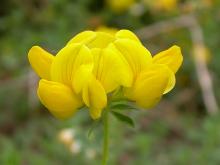Wildflowers, Grasses and Other Nonwoody Plants
Media

Species Types
Scientific Name
Astragalus crassicarpus (formerly A. mexicanus)
Description
Ground plum is a legume that bears plumlike, edible fruits. Its short, spikelike clusters of pea flowers can be white, cream, yellow, pink, or violet.
Media

Species Types
Scientific Name
Melilotus albus and M. officinale
Description
These two species of sweet clover are present all over America. Although they have been planted for forage, as bee plants, and as nitrogen-fixers, white and yellow sweet clover are now classified as invasive for their weediness and the problems they pose for natural habitats.
Media

Species Types
Scientific Name
Dicentra cucullaria
Description
Dutchman’s breeches, a common spring wildflower, is easy to identify. Note its bluish-green, fernlike leaves and its leafless stalks, from which dangle several white flowers shaped like old-fashioned knee breeches.
Media

Species Types
Scientific Name
Fragaria virginiana
Description
Wild strawberry is one of the parents of the cultivated strawberry and is one of our prized native wild edibles. It’s also a valuable food for innumerable animals, and it’s attractive in native wildflower gardens.
Media

Species Types
Scientific Name
Potentilla simplex
Description
Common cinquefoil, or five-finger, is named for its leaves, which are divided into five fingerlike leaflets. One of seven cinquefoils in Missouri, it blooms from April to June and is scattered nearly statewide.
Media

Species Types
Scientific Name
Ranunculus fascicularis
Description
There are nearly 20 species in the genus Ranunculus in Missouri. Identify early buttercup by its early blooming time, its distinctively shaped, usually hairy leaves, and its preference for open woods, glades, or prairies.
Media

Species Types
Scientific Name
Ranunculus harveyi
Description
A slender little buttercup growing in rocky, dry areas with acidic soils, Harvey’s buttercup occurs mostly in southern Missouri. One key to identify it is to examine the basal and stem leaves, which are quite different.
Media

Species Types
Scientific Name
Polemonium reptans
Description
As pretty as this wildflower is, the common name “Jacob’s Ladder” comes from its ladderlike leaves, which made people think of the story from Genesis in which Jacob dreams of a ladder reaching up to heaven.
Media

Species Types
Scientific Name
Pueraria montana
Description
Of the many invasive nonnative plants that were originally introduced to stop soil erosion and improve soils, kudzu is one of the worst. This “vine that ate the South” is often the first plant that comes to mind when we think of “invasive plants.”
Media

Species Types
Scientific Name
Lotus corniculatus
Description
Bird’s-foot trefoil forms low patches of bright yellow flowers along roadsides, having been planted to stabilize soil after road construction. Up close, it clearly has pea flowers. The leaves are cloverlike, with two leafy stipules at the base of each.
See Also
About Wildflowers, Grasses and Other Nonwoody Plants in Missouri
A very simple way of thinking about the green world is to divide the vascular plants into two groups: woody and nonwoody (or herbaceous). But this is an artificial division; many plant families include some species that are woody and some that are not. The diversity of nonwoody vascular plants is staggering! Think of all the ferns, grasses, sedges, lilies, peas, sunflowers, nightshades, milkweeds, mustards, mints, and mallows — weeds and wildflowers — and many more!





















